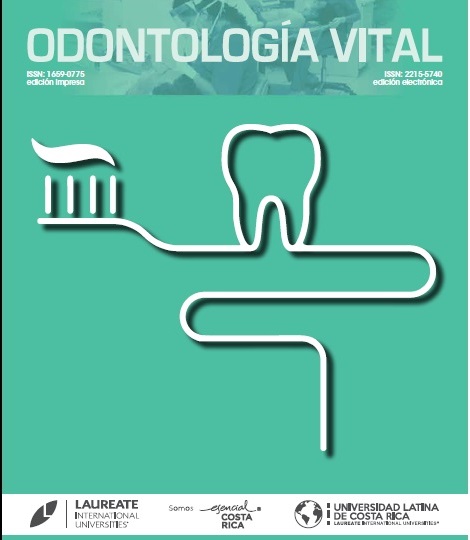Endodontic implants-Vitallium vs. Titanium Clinical case with 18 years follow-up
DOI:
https://doi.org/10.59334/ROV.v2i31.331Keywords:
Endodontic implant, endo/implant, endodontic stabilizerAbstract
One of the first and main considerations in modern odontology, is to preserve and maintain natural teeth, reason why alternative techniques have been searched, to preserve dental organs in mouth, as long as possible. That is why this article presents a clinical case where two frontal dental pieces, that had mobility in grade three were saved, after an orthodontic treatment maintained for more than two years- was removed. The case was successfully solved through two endodontic implants made from vitallium and titanium, with a follow-up for more than 18 years. The following is an exposition of the procedure of endodontic stabilizers, considering indications and contraindications.
Downloads
References
Ingle J., Bakland L., (1994). Endodoncia. Editorial Mc Graw-Hill Interamericana México, págs 794 – 796.
Rivera, M.A. (2000). Estabilizadores endodónticos. PO 21(7): 12-6.
Barzuna, M. Diversos usos de los implantes endodónticos: Reporte de tres casos clínicos. Rev de la ACCO – Costa Rica, mayo 2005
Strock, A.E., Strock, M.S. (1943). Method of reinforcing pulpless anterior teeth-preliminary report. J Oral Surg; 1:252-5.
Orlay, H.G. (1960). Endodontic splinting treatment in periodontal disease. Br Dent J ; 108:118-21.
Frank A.L. (1967). Improvement of the crown root ratio by endodontic endosseous implants. J Am Dent, Assoc; 74:451-62. https://doi.org/10.14219/jada.archive.1967.0083
Bruno, J.A: Estabilización intraósea, alcance y limitaciones de la técnica desde el punto de vista anatómico. Reflexiones sobre el arte quirúrgico. Odont uruguaya,8:311-25, mayo-junio 1954b.
Souza, M. El uso de estabilizadores intraóseos en apicectomías y en órganos paradentósicos. Rev. Asoc.Odontológica Argentina.42:325-41,1954
Ritacco, A. A., Ritacco, N. C. (1967). Implantes endodónticos intraóseos. Editorial Mundi – Argentina, pags17 – 163.
Maisto, O.: Endodoncia. Editorial Mundi S.A, Buenos Aires 1984, págs, 350-364.
Parmar, G., Pramodkumar, A. V. Custom-Fabricated Endodontic Implants: Report of Two Cases, Joe vol 26, may 2000, pág 301. https://doi.org/10.1097/00004770-200005000-00015
Sumi, Y., Mitsudoh, K., Ueda, M. (1998). Conservation of severely traumatized teeth using endodontic implants. A case report. J Oral Maxillofac Surg ; 56:240-2. https://doi.org/10.1016/S0278-2391(98)90877-1
Larios Cervantes, A., Aguilera Galaviz, A., Aceves, C. y Gaitan Fonseca, C. Diseño, fabricación y evaluación clínica de implantes trans-endodónticos de óxido de zirconio. Revista Iberoamericana de Ciencias ISSN 2334-2501,vol 3, número 1 Universidad Autónoma de Zacatecas, Zacatecas – México. ReIbCi – Febrero 2016 – www.reibci.org
Feldman, M. y Feldman, G. (1992). Endodontic stabilizers. JOE, vol. 18, no. 5, mayo . 245-248 pp. https://doi.org/10.1016/S0099-2399(06)81268-9
Madison, S., Bjorndal, A.M., (1988). Clinical application of endodontic implants. J Pros Dent ; 59:603-608. https://doi.org/10.1016/0022-3913(88)90079-0
Fagiskos, F. y cols. (1991). A new endodontic stabilizer implant device. J. Prosthet Dent 65(3):427-30. https://doi.org/10.1016/0022-3913(91)90237-Q
Ichida, E., Caputo, A.A. (1986). Stress induced by endodóntico stabilizer. J. Prosthet Dent 55(2):168-75. https://doi.org/10.1016/0022-3913(86)90335-5
Weine, F.S. (1993). Survival of the endodontic endosseous implant. J Endod. 19,524-8. https://doi.org/10.1016/S0099-2399(06)81496-2
Kishen, A. y cols. (1999). Biomechanics od endodontic endosseous implants – a comparative photoelastic evalua-tion. Endod Dent Traumatol 15(2):83-7. https://doi.org/10.1111/j.1600-9657.1999.tb00759.x
Parreira, F., Bramwell, J.D., Roahen, J.O. y cols. (1996), Histological response to titanium endosseous implants in dogs. J. Endod 22(4):161-4. https://doi.org/10.1016/S0099-2399(96)80092-6
Wolff1. J, et ál - A 22-year follow-up of an endodontic implant case report, Dental Traumatology 2015; 31: 409–412. https://doi.org/10.1111/edt.12174
Downloads
Published
Issue
Section
License
Copyright (c) 2019 Mayid Barzuna Ulloa

This work is licensed under a Creative Commons Attribution 4.0 International License.
Authors who publish with Odontología Vital agree to the following terms:
- Authors retain the copyright and grant Universidad Latina de Costa Rica the right of first publication, with the work simultaneously licensed under a Creative Commons Attribution 4.0 International license (CC BY 4.0) that allows others to share the work with an acknowledgement of the work's authorship and initial publication in this journal.
- Authors are able to enter into separate, additional contractual arrangements for the non-exclusive distribution of the Odontología Vital's published version of the work (e.g., post it to an institutional repository or publish it in a book), with an acknowledgement of its initial publication.
- Authors are permitted and encouraged to post their work online (e.g., in institutional repositories or on their website) prior to and during the submission process, as it can lead to productive exchanges, as well as earlier and greater citation of published work.







